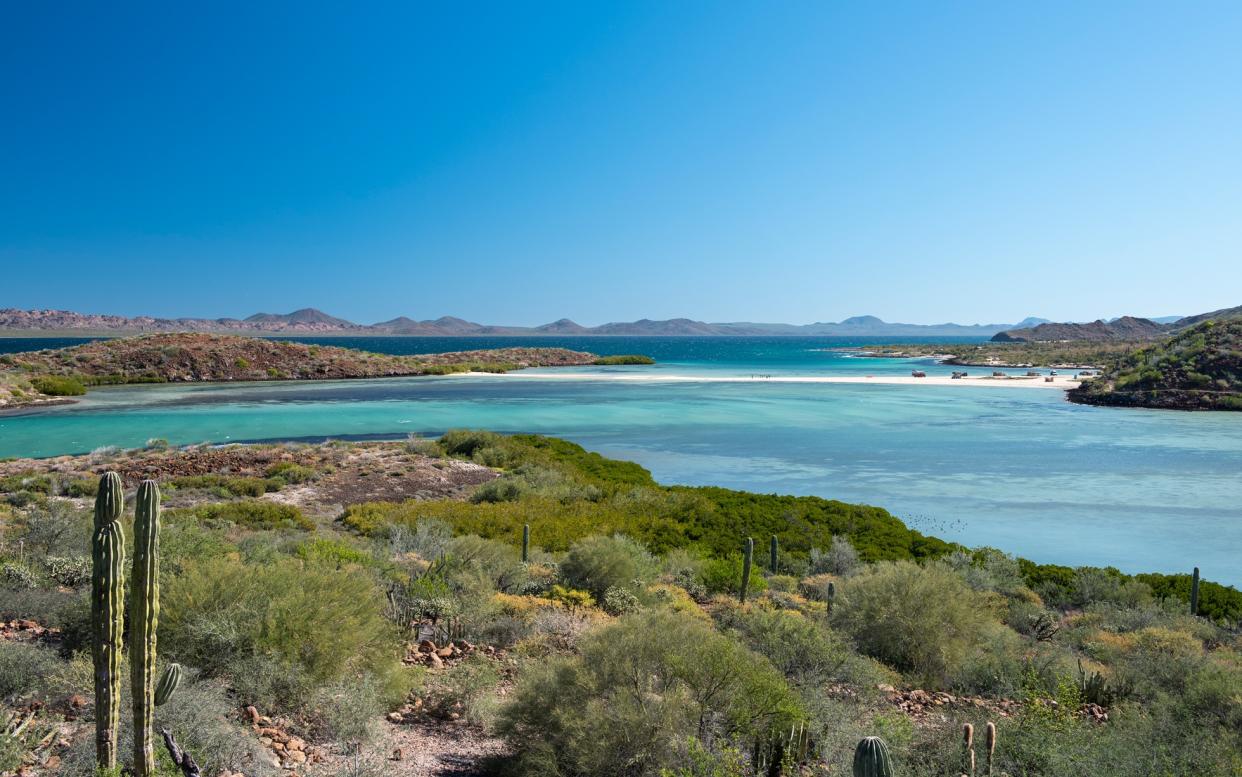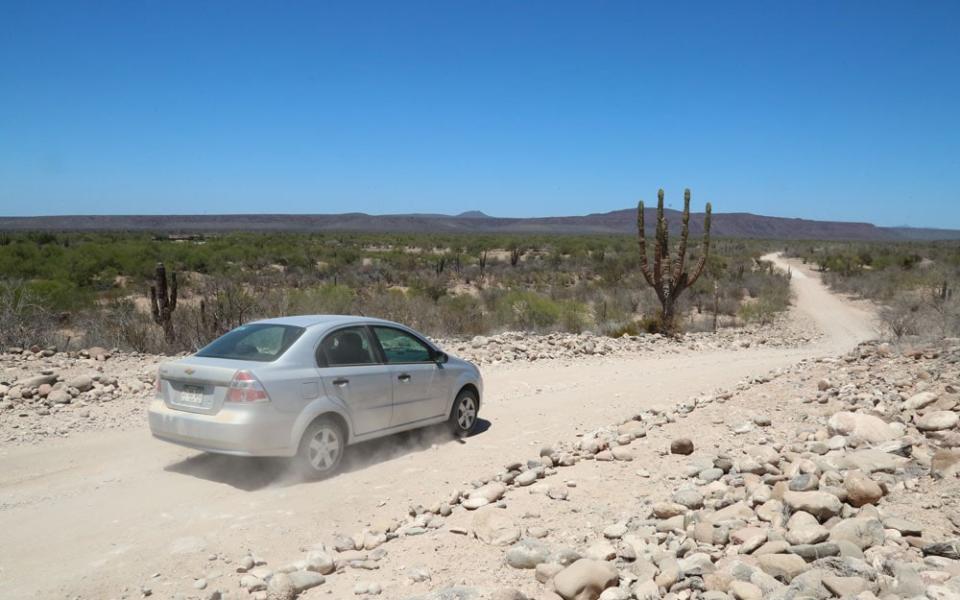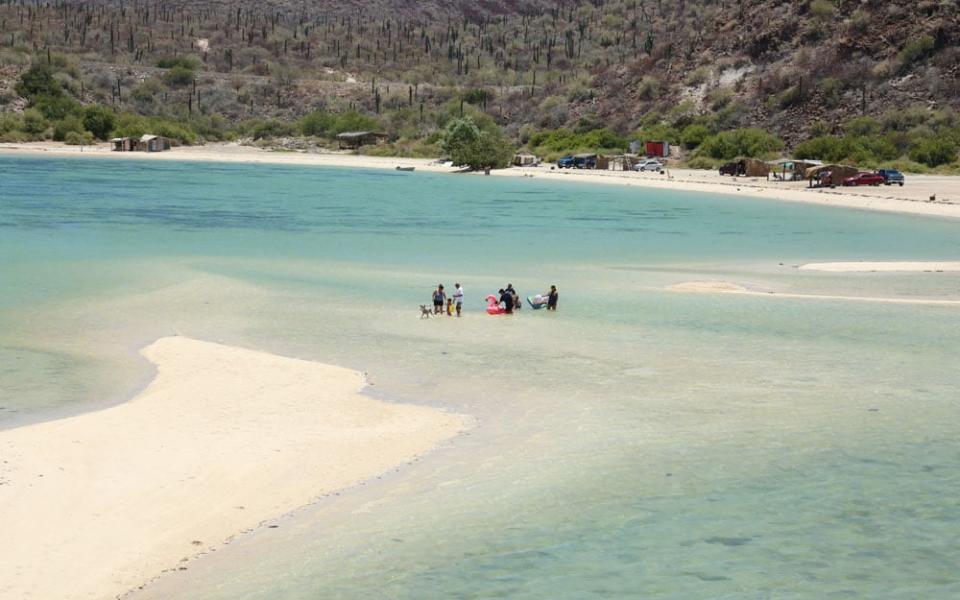Empty beaches and active volcanoes – this could be the world's best self-drive holiday

Bless the goats,” laughs Humberto Verdugo Garcia, outside the Cave of the Serpent. “They sometimes come up here to shelter from the wind and cold. It was the goats that led me up here – to all this.” He gestures towards the grey granite walls with a fish, a squid, a snake and a whale depicted in faded red paint.
There’s a lot to be said for getting off the beaten track. Following his goats up the rocky hills of the Sierra de la Giganta wilderness, 330ft above the road, helped Garcia find these ancient paintings. “I discovered them 19 years ago. None of my neighbours believed me but I persevered to get them recognised,” he says. Archaeologists from around the world have since visited, finding skeletons and artefacts inside the cave. The site has been recognised by Unesco, one of 200 known archaeological zones across the region. “They let me name it,” says Garcia, proudly.
For us, too, getting away from the standard tourist hotspots pays off on a new 12-day self-drive road trip on Mexico’s Baja Peninsula. Whales are the big draw here, but we hit the road outside the peak whale season (December-March), when the peninsula is much quieter, and in the brighter, more easy-going times before the Covid-19 crisis. Far beyond the hotels and resorts of San José del Cabo and Cabo San Lucas (Los Cabos), we find empty beaches, active volcanoes, and deer-like pronghorn.

First, having picked up a rental car from Los Cabos airport, we turn off into an area of sand dunes to reach the new Nobu Hotel, which opened last year. The 200-room beachfront hotel is the first Nobu in Latin America from chef Nobuyuki Matsuhisa and his business partner Robert De Niro. There’s a remote edge-of-the-world feel, with blustery empty stretches of sand on either side of the modernist, whitewashed building. Our spacious room, overlooking the Cortez Pool, has low-key cream and white décor, and a Nobu cookbook on the coffee table.
We dive straight in with jalapeño margaritas at the Playa Bar, along with Mexican classics: fresh guacamole, black corn tacos with fried shrimp. In the evening, we eat at Malibu Farm, where they load “green gold” on to their avocado pizza – happy days.

But the Japanese-Peruvian Nobu restaurant (with the odd Mexican touch thrown in) is the main attraction. “Irashaimasu,” shout staff in Japanese to welcome us. At a table overlooking the ocean, we order edamame with chilli, thin slices of salmon in sesame oil, and cauliflower with jalapeño sauce, each dish big on flavour. Waiters serve warm cups of sake and suggest how each course should be eaten. Black Atlantic cod, with miso in a lettuce leaf, is eaten with hands like a taco.
We drive north. A road trip like this is about detours and remote, in-between places, so we peel off en route to Todos Santos first to the dramatic cliffs at Cerritos and then to Los Cabos, where pelicans watch fishing boats come in, locals gathering to buy the day’s catch.
Todos Santos is a tourist town, its pink Hotel California said for years to be the inspiration for the song by The Eagles (the band sued to stop them making the association). We stay overnight, visiting the white Our Lady of Pilar Church on the plaza before taking the highway to La Paz on the east coast.
Joggers and skaters pass along La Paz’s Malecón in the evening, as we check out sculptures on the waterfront, from mermaids to Jacques Cousteau, who called the Sea of Cortez here the “Aquarium of the World”.
Next morning we take a boat across the ocean to Isla Espiritu Santo, chugging along deserted beaches and rocks where cormorants and frigate birds are nesting. Grumpy faces of green turtles poke out of the waves.

Some 600 sea lions make up a permanent colony at nearby Los Islotes. We find some of them on the rocks, sleek bodies shimmering as they bask in the sun. “If you see a sea lion in the water, don’t panic,” advises guide Manuel Rodriguez, handing out masks, fins and snorkels. “This is their ‘house’. They might swim and swirl around you.”
We fin through refreshingly cool water towards the rocks. A sea lion hurtles beneath us, spinning like a torpedo. An infant comes over, floating on its side, lifting a flipper, like a dog, showing where it wants to be stroked. Later, from behind an underwater boulder, an alpha male emerges, circling his territory.
Back on the mainland, we explore the beaches, including Balandra, where rippled patterns in the sand are visible through the clear water. At dusk, after the swimmers have left, we scramble up to a phone mast on a hilltop overlooking the bay. There are no people, only kamikaze pelicans dive-bombing into the water far below and turkey vultures gliding through purple skies.
The real adventure begins. After La Paz, there’s a feeling of leaving the tourist circuit behind for places fewer travellers reach. Roads are quieter. Hills around La Paz give way to dusty plains, dust devils whipping up.
We turn off Route 1 on to a juddering, rough track of white rocks and ash-like dust. There are no other cars (possibly for good reason) as we make slow progress through avenues of cardones cactus and red rock cliffs.
The road becomes a sand pit and our tyres sink into it. With sticks and stones, we try to dig, hoist and push our way out, but with no luck, just clouds of dust for our effort. With vultures circling and sunlight fading, we walk through the still desert to a small farm, where we find a father and son with a four-wheel drive who help haul our car out. We reach our hotel, dishevelled, coated in dust.
Next day we recharge our batteries in Loreto with a laid-back day watching pelicans diving into the harbour, then wander around the historic centre, visiting the bright yellow Museum of Jesuit Missions and the Church of Our Lady of Loreto. Loreto was the first Spanish settlement in Baja California and, from 1697 to 1777, served as the capital of Las Californias, a region that encompassed the Baja peninsula and what is now the state of California.
Driving along Conception Bay the next morning, we stop for a swim at the almost empty El Requesón beach, then continue on through palm trees at the oasis town of Mulegé and past the peaks of still-active Tres Virgenes.

The little town of San Ignacio is our final base. We spend the evening on the quiet plaza, children playing football in front of the Jesuit church San Ignacio de Kadakaamán Mission.
The flat scrubland, settlements and industrial zones on the drive north to Guerrero Negro the next day wouldn’t win any beauty pageants, as we cross Vizcaino Biosphere Reserve and drive over the border into Baja California Norte. The Vizcaino desert is one of the least populated areas in Mexico, with less than one person per square kilometre. There’s a Mexican phrase for remote locations like this: a place “where the wind turns around”.
We explore the white Dunes of Solitude by the ocean and spot ospreys eating fish on fence posts. Our final, most northerly stop is the Baja Pronghorn Reserve. Walking towards the enclosure to see the adult male peninsular pronghorns the ground moves. I look down and see a horned lizard: beady eyes, spiky head and tail, flat sandy body almost invisible against the ground. As I lie down to photograph it, a cluster of curious young pronghorns come over to study me on the ground.
“They are the main reason this area is protected,” warden Juan Carlos Cruz tells us in the visitor centre. “Hunted for the meat and horns, they are very close to extinction.”
Apart from tourists on package whale tours, few people make it to this remote reserve. “A lot of people drive by without knowing it’s here,” Cruz admits. “When I arrived here, I thought everything was just dry. But life’s very adaptable here. You can see desert foxes, and find pumas in the mountains. There are snakes, lizards, pelicans, horned sheep and the pronghorn. There’s a lot more life around here than people expect to find.”
Essentials
Journey Latin America (020 3553 9647) offers a 12-day self-drive holiday in Baja California, visiting Los Cabos, La Paz, Loreto and San Ignacio, from £1,604pp. The price includes car hire, mid-range hotels on a B&B basis and excursions. Nobu has deluxe rooms from £500 per night room only. British Airways (0844 493 0787) flies from London Heathrow to Los Cabos, Mexico from £787 return via Dallas Fort Worth, with onward travel on American Airlines.
The FCDO advises against all but essential travel to Mexico. For the latest travel advice, see gov.uk/guidance/coronavirus-covid-19-travel-corridors


